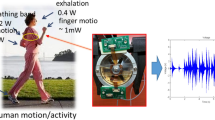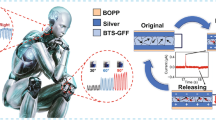Abstract
This paper introduces an artificial human joint working as testing machine for the experimental characterization of piezoelectric transducers for wearable applications. The diffusion of portable medical devices and low-power communication systems for telemedicine and telehealth is leading to the development of self-powered diagnostic systems supplied by small wearable generators. Laboratory tests are needed before the validation on human body for instance, to measure electric outputs, material properties and transducers reliability, as well as dedicated test benches must be designed and built. This work contributes to define experimental methodologies and test benches for the characterization of materials and electro-mechanical response of piezoelectric transducers. The proposed testing machine contributes to improve the effectiveness of harvesters design by providing preliminary data about performances, endurance and reliability. The same data are not easy to obtain from direct tests on the body due to the long test duration and the high repeatability and accuracy in imposing the movements. Additionally, the managing and control of multiple testing parameters is also needed, e.g. in design-of-experiments approaches. The functionality of the testing machine, which has been previously designed and built, has been proved with some qualitative measurements on piezo foil transducers coated with polymer.














Similar content being viewed by others
References
Teng XF, Zheng YT, Poon CC, Bonato P (2008) Wearable medical systems for p-health. IEEE Rev Biomed Eng 1:62–74
Yoo J, Yan L, Lee S, Kim Y, Yoo HJ (2010) A 5.2 mW self-configured wearable body sensor network controller and a 12 μW wirelessly powered sensor for a continuous health monitoring system. IEEE J Solid State Circ 45:178–188
Clanaman S (2013) MEMS medical gadgets for Obamacare impress CES visitors. MEMS J. www.memsjournal.com
Halperin D, Kohno T, Heydt-Benjamin TS, Fu K, Maisel WH (2008) Security and privacy for implantable medical devices. IEEE Pervasive Comput 7:30–39
De Pasquale G (2015) Biomechanical energy harvesting: design, testing and future trends in healthcare and human-machines interfacing. In: Mescia L, Losito O, Prudenzano F, IGI Global (eds) Innovative materials and systems for energy harvesting applications, Chapter 11, pp 290–340
Mitcheson PD, Yeatman EY, Rao GK, Holmes AS, Green TC (2008) Energy harvesting from human and machine motion from wireless electronic devices. Proc IEEE 96:1457–1486
De Pasquale G, Somà A, Fraccarollo F (2013) Comparison between piezoelectric and magnetic strategies for wearable energy harvesting. J Phys Conf Ser 476:012097
Cadei A, Dionisi A, Sardini E, Serpelloni M (2014) Kinetic and thermal energy harvesters for implantable medical devices and biomedical autonomous sensors. Meas Sci Technol 25:012003
Platt S, Farritor S, Garvin K, Haider H (2005) The use of piezoelectric ceramics for electric power generation within orthopedic implants. IEEE ASME T Mech 10:455–461
Cavallier B, Berthelot P, Nouira H, Foltete E, Hirsinger L, Ballandras S (2005) Energy harvesting using vibrating structures excited by shock. IEEE Ultrason Symp 2:943–945
Platt S, Farritor S, Haider H (2005) On low-frequency electric power generation with PZT ceramics. IEEE ASME T Mech 10:240–252
Naruse Y, Matsubara N, Mabuchi K, Izumi M, Suzuki S (2009) Electrostatic micro power generation from low-frequency vibration such as human motion. J Micromech Microeng 19(9):094002
Lewandowski B, Kilgore K, Gustafson K (2007) Design considerations for an implantable, muscle powered piezoelectric system for generating electrical power. Ann Biomed Eng 35:631–641
Potkay J, Brooks K (2008) An arterial cuff energy scavenger for implanted microsystems. In: International conference on bioinformatics and biomedical engineering, pp 1580–1583
Chen H, Liu M, Cand J, Wang Z (2009) Power harvesting using PZT ceramics embedded in orthopedic implants. IEEE Trans Ultrason Ferroelectr Freq Control 56:2010–2014
Almouahed S, Gouriou M, Hamitouche C, Stindel E, Roux C (2010) Self-powered instrumented knee implant for early detection of postoperative complications. In: Conference of the IEEE: engineering in medicine and biology society, pp 5121–5124
Lahuec C, Almouahed S, Arzel M, Gupta D, Hamitouche C, Jézéquel M, Stindel E, Roux C (2011) A self-powered telemetry system to estimate the postoperative instability of a knee implant. IEEE Trans Biomed Eng 58:822–825
De Pasquale G, Somà A (2013) Energy harvesting from human motion with piezo fibers for the body monitoring by MEMS sensors. In: Proceedings of DTIP, pp 79–84
De Pasquale G, Kim SG, De Pasquale D (2015) GoldFinger: wireless human-machine interface with dedicated software and biomechanical energy harvesting system. IEEE ASME T Mech, p 99
Goto H, Sugiura T, Kazui T (1998) Feasibility of the automatic generating system (AGS) for quartz watches as a leadless pacemaker power source: a preliminary report. Eng Med Biol Soc 1:417–419
Priya S, Inman DJ (2008) Energy harvesting technologies. Springer, London
Bianco M, Deyoung PD, Irani A, Li TH, Tran D and Wyld ML (2009) Energy generating systems for implanted medical devices. US patent 20090171404
Romero E, Warrington RO, Neuman MR (2009) Body motion for powering biomedical devices. In: Conference of proceedings of IEEE: engineering in medicine and biology society, pp 2752–2755
Nasiri A, Zabalawi SA, Jeutter DC (2011) A linear permanent magnet generator for powering implanted electronic devices. IEEE Trans Power Electron 26:192–199
Morais R, Silva NM, Santos PM, Frias CM, Ferreira JA, Ramos AM, Simoes JA, Baptista JM, Reis MC (2011) Double permanent magnet vibration power generator for smart hip prosthesis. Sens Actuators A Phys 172:259–268
Luciano V, Sardini E, Serpelloni M and Baronio G (2012) Analysis of an electromechanical generator implanted in a human total knee prosthesis. IEEE sensors applications symposium, pp 1–5
Rao Y, McEachern M, Arnold DP (2013) A compact human-powered energy harvesting system. J Phys Conf Ser 476:012011
Kymissis J, Kendall C, Paradiso J, Gershenfeld N (1998) Parasitic power harvesting in shoes. In: Proceedings of IEEE international symposium on wearable comput, pp 132–139
Siores E, Swallow L (2006) Apparatus for the detection and suppression of muscles tremors. UK patent GB-2444393-A
Granstrom J, Feenstra J, Sodano HA, Farinholt K (2007) Energy harvesting from a backpack instrumented with piezoelectric shoulder straps. Smart Mater Struct 16:1810–1820
Li Q, Naing V, Donelan JM (2009) Development of a biomechanical energy harvester. J Neuroeng Rehabil 6:22
Pozzi M, Zhu M (2011) Pizzicato excitation for wearable energy harvesters. SPIE Newsroom. doi:10.1117/2.1201104.003682
Leonov V (2011) Energy harvesting for self-powered wearable devices. In: Bonfiglio A, De Rossi D (eds) Wearable monitoring systems. Springer, New York
Yang B, Yun KW (2012) Piezoelectric shell structures as wearable energy harvesters for effective power generation at low-frequency movement. Sensor Actuators A Phys 188:427–433
Zhang J, Wang C, Chen W (2014) Surface and piezoelectric effects on the buckling of piezoelectric nanofilms due to mechanical loads. Meccanica 49:181–189
Zhu D (2011) Vibration energy harvesting: machinery vibration, human movement and flow induced vibration. In: Tan YK (ed) Sustainable energy harvesting technologies—past, present and future. Chapter 2. InTech Publisher, Janeza Trdine, Croatia, pp 25–54
Bowers BJ, Arnold DP (2009) Spherical, rolling magnet generators for passive energy harvesting from human motion. J Micromech Microeng 19:094008
Pellegrini SP, Tolou N, Schenk M, Herder JL (2012) Bistable vibration energy harvesters: a review. J Intell Material Syst Struct 24:1303–1312
Priya S (2007) Advances in energy harvesting using low profile piezoelectric transducers. J Electroceram 19:165–182
Lee M, Chen CY, Wang S, Cha SN, Park YJ, Kim JM, Chou LJ, Wang ZL (2012) A hybrid piezoelectric structure for wearable nanogenerators. Adv Mater 24:1759–1764
Klimiec E, Zaraska W, Zaraska K, Gąsiorski KP, Sadowski T, Pajda M (2008) Piezoelectric polymer films as power converters for human powered electronics. Microelectron Reliab 48:897–901
Niu P, Chapman P, Riemer R, Zhang X (2004) Evaluation of motions and actuation methods for biomechanical energy harvesting. In: IEEE 35th annual power electronics specialists conference, vol 3, pp 2100–2106
Wong LS, Hossain S, Edvinsson J, Rivas DH, Naas H (2004) A very low-power CMOS mixed-signal IC for implantable pacemaker applications. IEEE J Solid State Circ 39:2446–2456
Arfin KS (2011) Low power circuits and systems for wireless neural stimulation. PhD Thesis, Massachusetts Institute of Technology
Saati S, Lo R, Li PY, Meng E, Varma R, Humayun M (2010) Mini drug pump for ophthalmic use. Curr Eye Res 35:192–201
Power muscle stimulator (EMS) FDA 510 k, Model: GM320E(c). www.apria.com
Sarpeshkar R, Salthouse C, Ji-Jon S, Baker MW, Zhak SM, Turicchia L, Balster S (2005) An ultra-low-power programmable analog bionic ear processor. IEEE Trans Biomed Eng 52:711–727
Riemer R, Shapiro A (2011) Biomechanical energy harvesting from human motion: theory, state of the art, design guidelines, and future directions. J Neuroeng Rehabil 8:22
Romero E, Warrington RO, Neuman MR (2009) Energy scavenging sources for biomedical sensors. Physiol Meas 30:R35–R62
Romero E, Neuman MR, Warrington RO (2011) Rotational energy harvester for body motion. Proc MEMS 2011:1325–1328
Sue CY, Tsai NC (2012) Human powered MEMS-based energy harvest devices. Appl Energy 93:390–403
Pirola V (2003) Cinesiologia. Edi.Ermes Eds Milano, Italy
Kilgore KL, Lauer RT, Peckham PH (1994) A transducer for measurement of finger joint torques. In: Proceedings of IEEE, pp 938–939
Ngeo J, Tamei T, Shibata T (2012) Continuous estimation of finger joint angles using muscle activation inputs from surface EMG signals. In: Proceedings of IEEE EMBS, pp 2756–2759
De Pasquale G (2013) Energy harvesters for powering wireless systems. In: Uttamchandani D (ed) Handbook of MEMS for wireless and mobile applications. Chapter 11. Woodhead Publishing, Cambridge, UK, 345–400
Sugar T, Hitt JK, Boehler A, Hollander K, Ward JA (2011) Method and apparatus for harvesting energy from ankle motion. US patent number US20110278857A1
Hagood NW, von Floton A (1991) Damping of structural vibrations with piezoelectric materials and passive electrical networks. J Sound Vib 146(2):243–268
Guyomar D, Badel A, Lefeuvre E, Richard C (2005) Toward energy harvesting using active materials and conversion improvement by nonlinear processing. IEEE T Ultrason Ferr 52(4):584–595
Renno JM, Daqaq MF, Inman DJ (2009) On the optimal energy harvesting from a vibration source. J Sound Vib 320:386–405
Yu H, Zhou J, Deng L, Wen Z (2014) A vibration-based MEMS piezoelectric energy harvester and power conditioning circuit. Sensors 14:3323–3341
Leland ES, Wright PK (2006) Resonance tuning of piezoelectric vibration energy scavenging generators using compressive axial preload. Smart Mater Struct 15:1413–1420
Author information
Authors and Affiliations
Corresponding author
Rights and permissions
About this article
Cite this article
De Pasquale, G. Artificial human joint for the characterization of piezoelectric transducers in self-powered telemedicine applications. Meccanica 51, 2259–2275 (2016). https://doi.org/10.1007/s11012-016-0359-5
Received:
Accepted:
Published:
Issue Date:
DOI: https://doi.org/10.1007/s11012-016-0359-5




